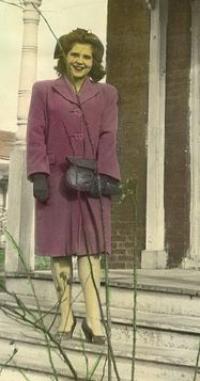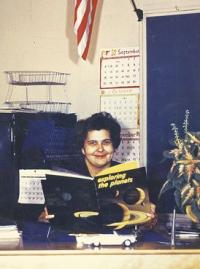
Serving the Vermont Champlain Valley Area for 45 Years
Main SectionsFront Page SportsValley VitalsIt's in the StarsStarwiseArchivesLinksAbout The VoiceContact Us |
Sharing Memories of School Days Gone ByTuesday March 10, 2009 By Cookie Steponaitis With just the blink of an eye we can all retrieve our favorite school memories. Remember that time in third grade science? Or perhaps it was that field trip in sixth grade? Was it the bus ride home from the championship or even that prom down at the lake? With each memory that you share, the moments that shaped your youth and future pathways provide a glimpse into who you are and what you value. School day memories also give us fascinating glimpses into times gone by, when going to school was vastly different than today and the schools were one room for all. Irene Stevens Thomas was born in Vergennes in 1924. She offers a unique perspective on going to school; for not only did she attend school in one room schools, but taught in them and then in other districts for thirty-six years. Irene attended Palmer School in Shelburne, schools in Hinesburgh, Monkton and the Middlebrook School in Ferrisburgh, Vermont. Today this school is the Chittenden Bank that is located at the entrance to the Aubuchon Hardware/Kinney Drugs/Shaws shopping Plaza. When Irene attended the Middlebrook school, it was located where Monkton Road and So. Middlebrook Road crossed, sitting in the field on the north side of the road. There were eight grades at the school and everyone walked or rode horses to the school. “There was no school bus or transportation,” commented Irene. “I walked about at least a couple of miles to school. Some days I would ride with my father in the wagon when he took the milk to the Shelburne Creamery.” Grades 1-8 included about twenty-five students and the day began at 9:00 a.m. and concluded at 4:00 p.m. We learned reading, mathematics, history, geography, spelling, penmanship, and English. We carried water from the Field House on Middlebrook Road and used wood to fuel the pot belly stove that was in the school house. We always had paper to use as well as pencils. The older students would help the younger students with their lessons. The teacher would work with a class or grade. Some of the older students would be hearing the spelling lessons and would help the younger students. Lunch was an hour and everyone brought a bag lunch. There was a hot dish brought by the parents and they sat on the top of the pot belly stove and stayed warm. Everyone had a warm lunch.” Irene found herself in school in 1944, but this time she was the teacher. She was paid $ 600.00 per year and taught eight grades at the Wilmarth School in Addison, Vermont. One of her first comments was in reference to suiting up for going home. “All the older students helped the younger students get into all their winter gear and saw that they got home safely. Another high point was when the library vehicle came once month from Montpelier and everyone got to get a new book. Reading was encouraged and to own your own books was so very important.” During her thirty-six years as a teacher Irene taught in schools ranging from Beacon Hill in Boston, to South Burlington Middle School and many one room schools in between. The eight years she spent as the one room school teacher of Stage Road School in North Ferrisburgh in the 1940’s and early 1950’s were some of her most rewarding. “The community supported and contributed to the school. We took the children to Boston and New York City. We went to Cape Cod and went to historic sites around the region. We went to the Mammoth Caves of Kentucky and really worked hard to learn all we could. There was money for school supplies from the town and we always had books for all the children.” While searching through her records, Irene located a newspaper article from the May 22, 1955 Burlington Free Press showing eighth grade students Jeanette Benoit, Charlene Bronson, Gordon Pickett and Verne Bronson standing in front of Colonial Williamsburg, Virginia and stated that the class trip covered over 2,000 miles. The article also stated how parents brought milk to school in half pint cartons fresh every day and described how visiting nurses and a dental clinic made sure their teeth and personal health was provided for. It even commented on the year end family picnic at Bayside in Mallets Bay and spoke of the creation of a new bowling league for the school children and their families. It concluded with extending thanks to the families and the town for the new books and materials that had been purchased for all the children for the new year that was arriving soon. While Irene marvels at the computers, technology and Internet that her grandchildren use to research, write and send lessons to their college professors, she wishes that they could pause and go back to the to the times she knew and loved. “There was a sense of family and unity in the one room schools,” she remarked, “that can not be duplicated today. Learning was done as a family and helping each other was a responsibility that was accepted and embraced. We all worked and learned together.” Many of us pass the old one room school buildings now being lived in or standing empty in the towns surrounding our homes, but how often do we give them a thought? They stand as icons of the educational system of the past and remind us only seldom of school days gone by. Irene and others who attended one room schools would like to offer a challenge. Talk to some relatives, neighbors or community members whose memories of school days include pot belly stoves, carrying water, and learning where grades were more a matter of age and than a matter of necessity and learning was for one and all.
|
AdvertisementsSearch our Archives |
Agricultural Weather Forecast:

© 2006-18 The Valley Voice • 656 Exchange St., Middlebury, VT 05753 • 802-388-6366 • 802-388-6368 (fax)
Valleywides: [email protected] • Classifieds: [email protected] • Info: [email protected]


 Printer Friendly
Printer Friendly